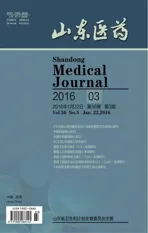乳腺浸润性导管癌组织中EpCAM、Vimentin、N-Cadherin的表达观察
2016-03-23付丽梅杨名辉付明霞李新军滨州市人民医院山东滨州256601
付丽梅,杨名辉,付明霞,李新军(滨州市人民医院,山东滨州 256601)
·论著·
乳腺浸润性导管癌组织中EpCAM、Vimentin、N-Cadherin的表达观察
付丽梅,杨名辉,付明霞,李新军(滨州市人民医院,山东滨州 256601)
摘要:目的观察乳腺浸润性导管癌组织中上皮细胞黏附分子(EpCAM)、波形蛋白(Vimentin)、N-钙黏附蛋白(N-Cadherin)的表达变化,并探讨其意义。方法 835例份乳腺浸润性导管癌组织(观察组),其中腺腔A型229例份(A组)、腺腔B型[人类表皮生长因子受体2(HER2)阴性]263例份(B组)、腺腔B型(HER2阳性)92例份(C组)、HER2过表达型90例份(D组)、三阴型161例份(E组),另取60例份乳腺良性病变组织作对照(对照组),检测各组EpCAM、Vimentin、N-Cadherin,并分析三者表达与乳腺浸润性导管癌临床病理参数的关系。结果观察组中EpCAM、Vimentin、N-Cadherin阳性率分别为53.4%、11.4%、9.7%,对照组分别为11.7%、0、0,两组比较,P均<0.05;A、B、C、D、E组EpCAM阳性率两两比较(除D组分别与B、E组比较外),A组Vimentin阳性率分别与B、C、D、E组比较,B组Vimentin阳性率分别与E组比较,E组N-Cadherin阳性率与A、B组比较,B组N-Cadherin阳性率分别与C、D组比较,P均<0.05。EpCAM、Vimentin、N-Cadherin表达均与乳腺浸润性导管癌肿瘤直径、淋巴结转移、组织学分级、ER、PR、临床分期有关,而且EpCAM与HER2有关(P均<0.05)。观察组中EpCAM与Vimentin、N-Cadherin表达呈正相关(r=0.214、0.136,P均<0.05),A、C、E组中EpCAM与Vimentin表达呈正相关(r=0.301、0.290、0.270,P均<0.05),C、E组中EpCAM与N-Cadherin表达呈正相关(r=0.003、0049,P均<0.05)。结论 乳腺浸润性导管癌组织中EpCAM、Vimentin、N-Cadherin表达升高,尤其在三阴型中呈高表达,其可能参与该型乳腺浸润性导管癌的发展、转移过程。
关键词:乳腺肿瘤;乳腺癌;上皮细胞黏附分子;波形蛋白;N-钙黏附蛋白
乳腺癌是女性常见恶性上皮性肿瘤,具有较强的异质性,其中雌激素受体(ER)、孕激素受体(PR)、人类表皮生长因子受体2(HER2)[1]均为阴性的三阴型乳腺癌具有侵袭性强、预后不良的特点。研究乳腺癌侵袭性生长的相关机制,有助于寻找新的治疗靶点。上皮细胞黏附分子(EpCAM)是一种跨膜糖蛋白,参与信号转导、细胞增殖、分化、迁移等多种生物学功能[2]。上皮-间质转化(EMT)是指在特定的情况下,具有上皮特征细胞向具有间叶特征细胞转化的过程,这一过程与肿瘤转移密切相关。本研究通过免疫组化法检测乳腺浸润性导管癌组织中EpCAM、EMT标志物波形蛋白(Vimentin)、N-钙黏附蛋白(N-Cadherin)表达变化,并探讨其意义。现将结果报告如下。
1材料与方法
1.1材料收集2000年1月~2009年12月滨州市人民医院病理科有完整切片、石蜡档案及病例资料的乳腺浸润性导管癌(非特殊型)组织835例份(观察组),患者均为女性,年龄26~77(50.86±10.22)岁。所有患者均经病理证实,且术前未进行任何放疗、化疗或内分泌治疗。绝经前患者426例,绝经后患者409例。肿瘤直径≤2 cm者344例,2~5 cm者448例,>5 cm者43例。有淋巴结转移454例,无淋巴结转移381例。组织学分级Ⅰ级39例,Ⅱ级350例,Ⅲ级446例。ER阳性 532例,ER阴性303例。PR阳性 512例,PR阴性323例。HER2阳性 182例,HER2阴性653例。临床分期Ⅰ、Ⅱ级614例,Ⅲ、Ⅳ级221例。根据免疫组化结果及2013年St Gallen国际乳腺癌大会乳腺癌分子分型标准分型[3],腺腔A型229例份(A组),腺腔B型(HER2阴性)263例(B组),腺腔B型(HER2阳性)92例(C组),HER2过表达型90例(D组),三阴型161例(E组)。另取同期60例份乳腺良性病变组织作为对照组。
1.2EpCAM、Vimentin、N-Cadherin检测方法标本以4%甲醛固定,石蜡切片脱蜡至水,PBS洗后对组织进行抗原修复,修复方式采用pH 6.0柠檬酸盐热修复,3%过氧化氢封闭内源性过氧化物酶,PBS洗后加第一抗体,室温下孵育60 min,PBS冲洗后加即用型MaxVisionTM试剂,室温下孵育15 min。PBS冲洗后加新鲜配制的DAB溶液,自来水冲洗,苏木素复染,脱水,透明,中性树胶封固。以PBS替代一抗作为阴性对照。结果判定标准:EpCAM、N-Cadherin阳性定位于细胞膜或细胞质,参照文献[4]方法计算阳性率;Vimentin阳性定位于细胞质,参照文献[5]方法计算阳性率。
1.3统计学方法采用SPSS20.0统计软件。计数资料比较采用χ2检验;相关性分析采用Spearman相关分析法。P<0.05为差异有统计学意义。
2结果
2.1各组EpCAM、Vimentin、N-Cadherin表达比较观察组中EpCAM、Vimentin、N-Cadherin阳性率分别为53.4%(446/835)、11.4%(95/835)、9.7%(81/835),对照组分别为11.7%(7/60)、0(0/60)、0(0/60),两组比较,P均<0.05。A、B、C、D、E组EpCAM阳性率分别为19.2%(44/229)、73.0%(192/263)、48.9%(45/92)、72.2%(65/90)、62.1%(100/161),两两比较(除D组分别与B、E比较外),P均<0.05;Vimentin阳性率分别为3.9%(9/229)、11.4%(30/263)、14.1%(13/92)、11.1%(10/90)、20.5%(30/161),A组分别与B、C、D、E组比较,B组与E组比较,P均<0.05;N-Cadherin阳性率分别为7.0%(16/229)、5.7%(15/263)、12.0%(11/92)、12.2%(11/90)、17.4%(28/161),E组分别与A、B组比较,B组分别与C、D组比较,P均<0.05。
2.2EpCAM、Vimentin、N-Cadherin表达与乳腺浸润性导管癌临床病理参数的关系EpCAM阳性表达与乳腺浸润性导管癌肿瘤直径、淋巴结转移、组织学分级、ER、PR、HER2、临床分期有关,Vimentin、N-Cadherin阳性表达与乳腺浸润性导管癌肿瘤直径、淋巴结转移、组织学分级、ER、PR、临床分期有关(P均<0.05)。详见表1。

表1 EpCAM、Vimentin、N-Cadherin表达与乳腺浸润性导管癌临床病理参数的关系
2.3观察组中EpCAM、Vimentin、N-Cadherin表达的相关性观察组中EpCAM与Vimentin、N-Cadherin表达呈正相关(r=0.214、0.136,P均<0.05)。A、C、E组中EpCAM与Vimentin表达呈正相关(r=0.301、0.290、0.270,P<0.05);C、E组中EpCAM与N-Cadherin表达呈正相关(r=0.003、0049,P均<0.05)。
3讨论
乳腺癌是一种异质性很强的恶性肿瘤,根据ER、PR、HER2及Ki-67的免疫组化染色结果,可以将乳腺癌分为腺腔A型、腺腔B型(HER2阴性)、腺腔B型(HER2阳性)、HER2过表达型及三阴型[2]。三阴型乳腺癌由于激素受体和HER2阴性表达,内分泌治疗和HER2靶向治疗药物都无法使用,对于晚期患者缺乏有效的治疗手段,预后较差。
EpCAM在很多上皮性肿瘤中过表达,如乳腺癌、卵巢癌、前列腺癌、胃癌等[6]。本研究显示,观察组EpCAM阳性率为53.4%,其中三阴型高达62.1%。Abd等[7]检测了126例乳腺癌组织EpCAM,发现EpCAM阳性率为72.2%,其中三阴型为88.9%。Soysal等[4]报道,1 365例乳腺癌中EpCAM过表达率为48%,136例三阴型乳腺癌中EpCAM过表达率为63.8%。本研究发现,EpCAM阳性表达与乳腺浸润性导管癌肿瘤直径、淋巴结转移、组织学分级、ER、PR、HER2、临床分期有关。Soysal等[4]也发现,EpCAM表达与乳腺癌肿瘤分期、淋巴结转移、肿瘤直径、组织学分级、ER、HER2相关。另有研究[8]发现,EpCAM与乳腺癌组织学分级、肿瘤直径、病理类型等有关。李金梅等[9]报道,EpCAM过表达与三阴型乳腺癌组织学分级、淋巴结转移呈正相关。体外乳腺癌细胞株实验显示,EpCAM可增强乳腺癌细胞株增殖活性和侵袭能力[10]。上述结果提示,EpCAM可能参与乳腺癌特别是三阴型乳腺癌的进展和转移过程。
EMT是指上皮性癌细胞失去其上皮特征,并获得间叶细胞特征的一过性过程,其在乳腺癌发生、进展和转移中也发挥重要作用。Choi等[5]发现,在乳腺导管原位癌向浸润性乳腺癌转变的过程中,EMT现象增强,表现为Vimentin、N-Cadherin等间叶标记物表达上调,E-Cadherin等表达下调。Jeong等[11]使用免疫组化法检测了492例乳腺癌组织Vimentin、N-Cadherin,发现Vimentin阳性率为8.5%,N-Cadherin阳性率为9.6%,其中在三阴型乳腺癌中Vimentin阳性率为24.5%、N-Cadherin阳性率为13.7%。本研究发现,乳腺浸润性导管癌Vimentin阳性率为11.4%,N-Cadherin阳性率为9.7%,其中三阴型阳性率更高。
乳腺癌组织中EpCAM与EMT关系的研究较为罕见。本研究发现,乳腺癌组织中EpCAM表达与Vimentin、N-Cadherin表达呈正相关,在三阴型乳腺癌中也是如此。Ni等[12]发现,EpCAM在前列腺癌中可下调E-Cadherin表达。另有报道,在人类正常乳腺上皮细胞中EpCAM可降低E-Cadherin表达。Nagahara等[13]认为,肝细胞癌细胞株过表达EpCAM时,EMT现象也增强。因此,EpCAM很可能参与乳腺癌EMT过程,但具体机制尚不清楚。Gao等[14]在体外细胞实验中发现,EpCAM参与了TGF-β1介导的EMT,当EpCAM过表达时,可增强TGF-β1介导的EMT,敲除EpCAM可抑制EMT。Philip等[15]认为,紧密连接蛋白7可招募并裂解EpCAM,裂解后的EpCAM细胞内片段能促进EMT相关转录因子的表达,在敲除了紧密连接蛋白7的结肠癌细胞中,Vimentin和纤维连接蛋白水平下降,肿瘤细胞生长和转移能力下降。
参考文献:
[1] 《乳腺癌HER2检测指南(2014版)》编写组.乳腺癌HER2检测指南(2014版)[J].中华病理学杂志,2014,43(4):262-267.
[2] Schnell U, Cirulli V, Giepmans BN. EpCAM: structure and function in health and disease[J]. Biochim Biophys Acta, 2013,1828(8):1989-2001.
[3] Goldhirsch A, Winer EP, Coates AS, et al. Personalizing the treatment of women with early breast cancer: highlights of the St Gallen International Expert Consensus on the Primary Therapy of Early Breast Cancer 2013[J]. Ann Oncol, 2013,24(9):2206-2223.
[4] Soysal SD, Muenst S, Barbie T, et al. EpCAM expression varies significantly and is differentially associated with prognosis in the luminal B HER2(+), basal-like, and HER2 intrinsic subtypes of breast cancer[J]. Br J Cancer, 2013,108(7):1480-1487.
[5] Choi Y, Lee HJ, Jang MH, et al. Epithelial-mesenchymal transition increases during the progression of in situ to invasive basal-like breast cancer[J]. Hum Pathol, 2013,44(11):2581 -2589.
[6] Patriarca C, Macchi RM, Marschner AK, et al. Epithelial cell adhesion molecule expression (CD326) in cancer: a short review[J]. Cancer Treat Rev, 2012,38(1):68-75.
[7] Abd EN, Abd ED. Clinicopathologic implications of EpCAM and Sox2 expression in breast cancer[J]. Clin Breast Cancer, 2014,14(1):e1-e9.
[8] Agboola AJ, Paish EC, Rakha EA, et al. EpCAM expression is an indicator of recurrence in basal-like breast cancer[J]. Breast Cancer Res Treat, 2012,133(2):575-582.
[9] 李金梅,张金库,周炳娟,等.三阴性乳腺癌中EpCAM和Sox2的表达及临床意义[J].临床与实验病理学杂志,2014,30(9):1040-1042.
[10] Gao J, Liu X, Yang F, et al. By inhibiting Ras/Raf/ERK and MMP-9, knockdown of EpCAM inhibits breast cancer cell growth and metastasis[J]. Oncotarget, 2015, 6(29):27187-27198.
[11] Jeong H, Ryu YJ, An J, et al. Epithelial-mesenchymal transition in breast cancer correlates with high histological grade and triple-negative phenotype[J]. Histopathology, 2012,60(6B):E87- E95.
[12] Ni J, Cozzi P, Hao J, et al. Epithelial cell adhesion molecule (EpCAM) is associated with prostate cancer metastasis and chemo/radioresistance via the PI3K/Akt/mTOR signaling pathway[J]. Int J Biochem Cell Biol, 2013,45(12):2736-2748.
[13] Nagahara T, Shiraha H, Sawahara H, et al. Hepatic stellate cells promote upregulation of epithelial cell adhesion molecule and epithelial-mesenchymal transition in hepatic cancer cells[J]. Oncol Rep, 2015,34(3):1169-1177.
[14] Gao J, Yan Q, Wang J, et al. Epithelial-to-mesenchymal transition induced by TGF-beta1 is mediated by AP1-dependent EpCAM expression in MCF-7 cells[J]. J Cell Physiol, 2015,230(4): 775-782.
[15] Philip R, Heiler S, Mu W, et al. Claudin-7 promotes the epithelial-mesenchymal transition in human colorectal cancer[J]. Oncotarget, 2015,6(4):2046-2063.
Expression of EpCAM, vimentin and N-cadherin in breast infiltrating ductal carcinoma
FULimei,YANGMinghui,FUMingxia,LIXinjun
(BinzhouPeople′sHospital,Binzhou256601,China)
Abstract:Objective To observe the expression changes of vimentin, N-cadherin, epithelial cell adhesion molecule (EpCAM) in breast infiltrating ductal carcinoma, and to investigate their clinical significance. MethodsTotally 835 cases of breast infiltrating ductal carcinoma tissues (observation group) were divided into 229 cases of luminal A (group A), 263 cases of luminal B [hman epidermal growth factor receptor-2 (HER2)-] (group B), 92 cases of luminal B (HER2+) (group C), 90 cases of HER-2 with overexpression (group D) and 161 cases of triple-negative subtype (group E). Meanwhile, another 60 cases of benign breast lesions (control group) were also studied. The expression of EpCAM, vimentin and N-cadherin was detected in the observation group and the control group, and their relationships with the clinical-pathological parameters of breast infiltrating ductal carcinoma were analyzed. ResultsThe positive expression rates of EpCAM, vimentin and N-cadherin in the observation group were 53.4%, 11.4% and 9.7% respectively, and those in the control group were 11.7%, 0, 0, respectively. Significant differences were found between the observation group and control group (all P<0.05). The differences were significant in the following comparisons: the multiple comparisons among EpCAM expression of groups A, B, C, D and E (except for D vs B and D vs E); the vimentin expression of group A as compared with that of groups B, C, D and E respectively; the vimentin expression of group B as compared with that of group E; the N-cadherin expression of group E as compared with that of groups A and B respectively; the N-cadherin expression of group B as compared with that of group C and D (all P<0.05). The expression of EpCAM, vimentin and N-cadherin was associated with tumor diameter, lymph node metastasis, histological grade, ER, PR and TNM stage (all P<0.05); in addition, the expression of EpCAM was also related with HER2 (P<0.05). The expression of EpCAM in the observation group was positively correlated with the expression of vimentin and N-cadherin (r=0.214, 0.136; all P<0.05). EpCAM expression was positively correlated with vimentin expression in the groups A, C and E (r=0.301, 0.290 and 0.270, respectively; all P<0.05), and EpCAM expression was positively correlated with N-cadherin expression in the groups C and E (r=0.003,0049; all P<0.05). ConclusionsThe expression of EpCAM, vimentin and N-cadherin increases in the breast infiltrating ductal carcinoma tissues, especially in the triple-negative subtype, which may be involved in the development and metastasis of this type of breast infiltrating ductal carcinoma.
Key words:breast neoplasm; breast carcinoma; epithelial cell adhesion molecule; vimentin; N-cadherin
(收稿日期:2015-09-07)
中图分类号:R737.9
文献标志码:A
文章编号:1002-266X(2016)03-0001-04
doi:10.3969/j.issn.1002-266X.2016.03.001
通信作者简介:李新军(1980-),男,硕士,主治医师,主要研究方向为乳腺病理学。E-mail: lixinjunhe@163.com
作者简介:第一付丽梅(1981-),女,硕士,主治医师,主要研究方向为肿瘤病理学。E-mail: fulimeipathology@163.com
基金项目:山东省科技发展计划政策引导类项目(2013YD18032)。
